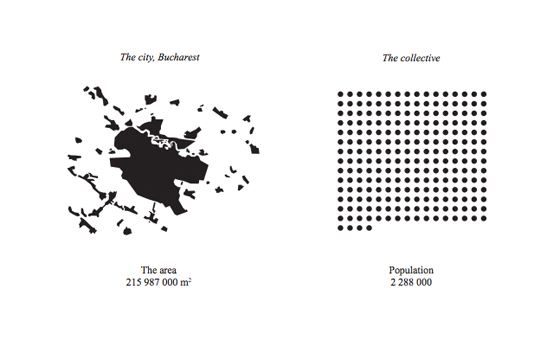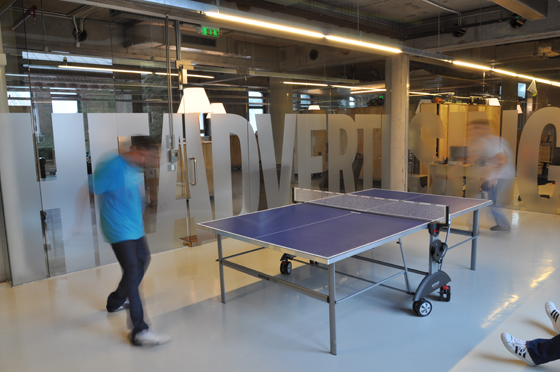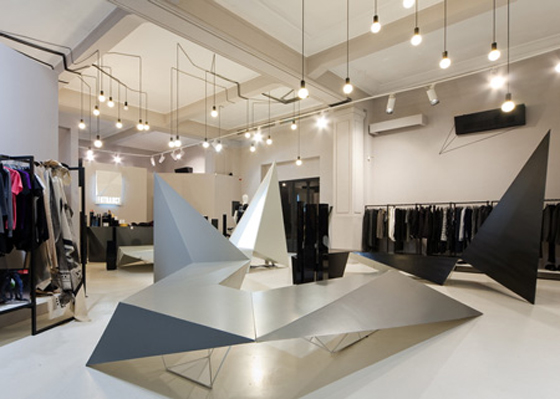Bucharest: The 2010 Mix
Texte par Alexander Horne
Oslo, Norvège
16.12.10
In the world of design, China's rapid-manufacturing prowess and the oil-fuelled 'tabula rasa' urban developments of countries such as the UAE and Kazakhstan have given cause for thought in a typically Western-dominated field. But what of the countries bridging East and West? What of their design credentials? Turkey may grab the headlines for its EU tug-of-war and glossy design events, but it is the independent, cut-and-paste eclecticism of one of its Black Sea neighbours – Romania – that is capturing the imagination of those interested in grassroots design with a soul.
Romania has had a hard time in recent years. Left bruised by some undeserved blame for the backlash against the Roma diaspora in some parts of Europe (less than 2% of this indigenous group make up the population of Bucharest), matters have not been helped by the country's substantial debt to the International Monetary Fund. Post-Ceausescu and since joining the EU, however, things had been going rather well, so well in fact that Romania picked up the questionable nickname 'Tiger of the East' for its rapid economic growth in the early Noughties.
An example of the mix of heritage and contemporary in Bucharest's architecture. This building houses the Union of Romanian Architects, and was originally a meeting place for the intellectual elite at the end of the 19th century
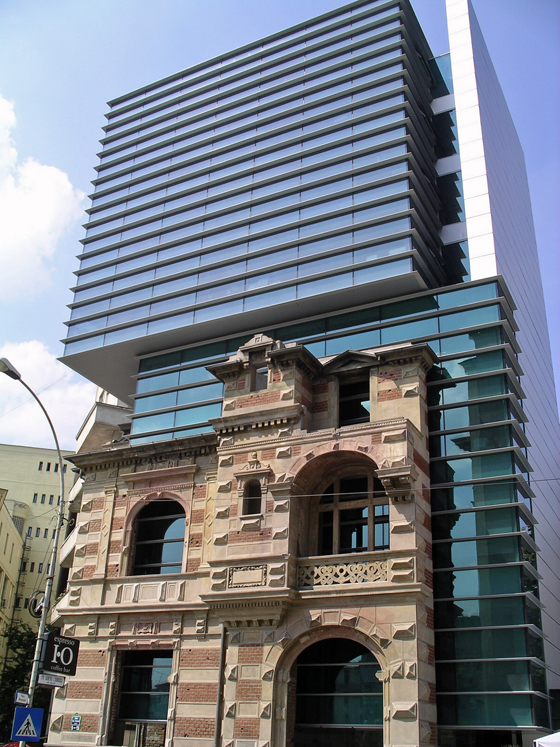
An example of the mix of heritage and contemporary in Bucharest's architecture. This building houses the Union of Romanian Architects, and was originally a meeting place for the intellectual elite at the end of the 19th century
×On the ground, the concrete jungle that is Bucharest has been the heartbeat of this renaissance. The city makes up almost a tenth of Romania's population, over two million people, and aesthetically is a kind of 1920s-Paris-meets-Mad-Max, following some kind of apocalyptic child's tantrum – a patchwork of romantic Nouveau classicism from the past (from the days when the city was known as 'Little Paris'), desolate villas, unfinished paving and the monstrosities of the Ceausescu era. Despite the pick-and-mix appearance of the city, it is arguably becoming a place of serious interest for culturally minded visitors, in no small part due to the independent creatives living and working there.
Image from the '1:1' exhibition at the Venice Biennale 2010. The exhibition is a room within a room, giving a perspective of personal space in Bucharest, inside and outside the inner room. Photo Unu La Unu
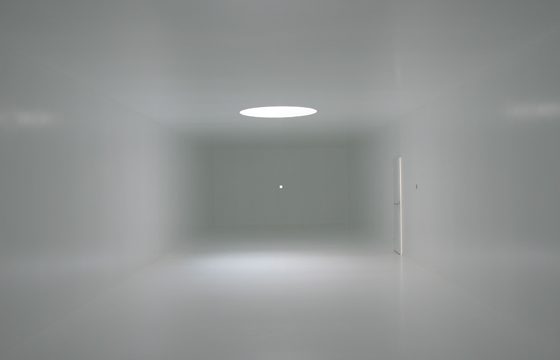
Image from the '1:1' exhibition at the Venice Biennale 2010. The exhibition is a room within a room, giving a perspective of personal space in Bucharest, inside and outside the inner room. Photo Unu La Unu
×Attempting to get a purchase on what it was really like before and after Ceausescu can be like wading through a swamp in a blindfold. You won't get very far. There are some who murmur about missing the order and security they had. What is clear is that a lot of people left the country, fleeing for their own safety, but also for peace of mind and freedom. Democracy and the mini-boom of the early Noughties saw some of these people return with new ideas, different perspectives and renewed hope. One of the consequences of a new generation of young Romanians who now have the lifestyle choice of emigrating to study abroad, and of returning, is the introduction into the country of new creative influences.
The notion of a mixed style is not a new approach, however. According to local creative Corvin Cristian, ‘Even before the wars, Romania had trouble in having a style of its own.' He goes on to explain that ‘The Orthodox roots mixed with the Ottoman style, Slavic, some Austrian and finally the omnipotent French influence, to name just a few, created charming mix-matches still surviving in some parts of Bucharest.' Contemporary Bucharest showcases this mix-match through all-night audio-visual events in art galleries, design festivals and international architecture forums, new business ventures, publications and bars – concepts that can appear tired in some Western countries but have a new and fresh energy here. New ideas need, however, some contextual rules.
Perspective Bucharest diagrams from the '1:1' Romanian pavilion team at the Venice Biennale 2010
Since setting up in 2001, Square One has become one of only a few Bucharest-based architecture and design studios to reach out to an international audience. When asked what it was like to start a practice in the early part of the decade, they explain that they had to create their 'own system of values in a situation when you were almost unable to find any within your own professional environment'. In their eyes, Bucharest in 2001 was a period when there 'was still a great deal of confusion regarding the position of architecture in society'. Perhaps it is due to the longevity and progressive effect of architecture and urban-design projects that architecture studios have not yet gathered as much international attention as contemporary Bucharest's graphic designers, film-makers, DJs and street artists.
As if testament to the all-encompassing bric-a-brac approach of these aforementioned fields, Square One design buildings, interiors and objects, often creating the furniture that accompanies their own architectural projects. One of the best recent examples of this complete design package is the clothing store 'Entrance' in Bucharest, a jagged forest of futuristic geometric shapes and intersections that point toward minimalism.
Ad agency Headvertising's premises, designed by Corvin Cristian, which feature moveable furniture on wheels and plywood lampshades, all serving to create a child-like fairytale space to inspire staff
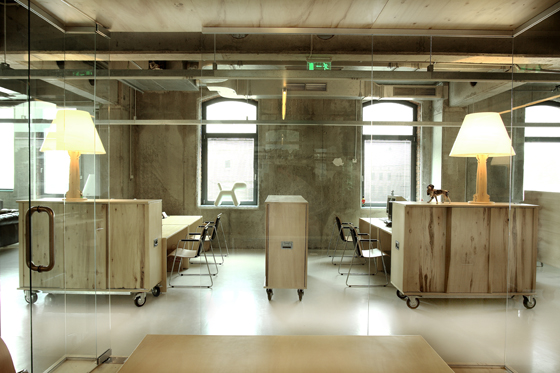
Ad agency Headvertising's premises, designed by Corvin Cristian, which feature moveable furniture on wheels and plywood lampshades, all serving to create a child-like fairytale space to inspire staff
×Speaking to some locals, however, it seems that their most favoured Square One design is the surrealist neon dazzle that is 'Embryo' nightclub's interior. A popular haunt with the new wave of Bucharest creatives, the original club concept is apparently now defunct, so you will just have to guess how a nightclub with an interior based on the inner details of the birth process looks like. Square One maintain, however, that they are not only conscious of style in their design process: 'Besides the technical challenges that both the old and new bring, the key issues are “authenticity” for the old and “style” for the new.'
Corvin Cristian's playful interior design for ad agency Headvertising's Bucharest offices
The relative lack of press coverage and critical commentary to date on Romanian design becomes all the more apparent when talking to some of the country's current creative crop, who are not accustomed to being asked for images for their work or for their opinions as design professionals. This is a situation that new communication portals for Romanian design and architecture, such as the Dezeen-style design-feed site Intro, is aiming to change for the better. It's also worth noting that many architects work on advertising and set design before landing their own interiors and housing projects. This was the way in for Square One and Corvin Cristian.
A product designer, architect and art director, Cristian mixes set design and temporary-structure projects for commercial clients with his authentic fairy-tale spaces for private clients. His design for the interior of Headvertising's offices, completed in 2009, is probably most worthy of mention for its child-like playfulness and approach to 'old' and 'new' authenticity. Located in the former Romanian Stock Exchange building, the lamps are made of plywood to add a domestic feel and most of the furniture has wheels, allowing constant mobility around the space (which includes a room dedicated to table tennis). The end result is like a 9-to-5 'Alice in Wonderland' workspace. There is a lot more to this building than flexible furniture and ping-pong, though; referred to as the Ark Center, the former Romanian Stock Exchange is a fine example of an architectural solution to the paradox of Bucharest’s old and new.
Re-Act’s rehabilitation of the former Stock Exchange, located in the Rahova area of Bucharest
While Corvin Cristian delivered his own creative vision for Headvertising's premises, the full building renovation came courtesy of a design by Mario Kubius, head of Re-Act Architecture. The original heritage-listed building dates from the 19th century, but has gone through several major facelifts and prior to any investment sat annexed from the old city centre and any main traffic routes thanks to the spiralling dominance of Ceausescu’s palace. The Ark Center project brief outlined the importance of transforming the site into an environment to inspire the exchange of ideas and help rebuild the identity of the surrounding area. In short, the investors were looking for a culture centre to host public and private initiatives.
Aesthetically, the finished building retains existing elements of the exterior façade alongside newly added transparent walls that keep the building visibly lit by day, and sometimes by night. The interior of the building, on the other hand, is almost completely reworked due to the damage is sustained from a large fire in 1990. Popular with local creatives, the Ark Center's spaces are currently rented by an architecture studio, a television production company and the Bucharest International Center of Contemporary Art, among others. As a concept, the Ark Center successfully celebrates the collage nature of Bucharest with a mix of old and new, public and private, culture and industry. Most importantly, however, the building gives something of an identity to the neighbouring community – empowering locals, as opposed to just those who can afford to buy, live or work in such structures.
Square One’s futuristic and minimal interior for Bucharest's ‘Entrance’ store
Re-Act and other medium-to-large-sized studios such as D.S.B.A (Dorin Stefan Birou Architectura) buck the trend of mixing fields of work by mostly focusing on residential and private architectural projects, which, in Bucharest, is by no means an easy task. A large proportion of buildings are graded on how secure and stable they are, bearing in mind the area is no stranger to earthquakes. Alarmingly, when a building is deemed to be in danger of collapsing, this does not stop it from being rented out or even sold. The reality is that a considerable amount of structures are on the edge, so to speak. (And their occupants, too.)
Yet, it is the precarious mix of old, new and upcoming structures that makes the cityscape of Bucharest so distinct. A raggedy urban line up that, when mixed with stray dogs and abandoned villas, may occasionally appear somewhat Wild West. Luckily, it's only in appearance these days that the city comes across as somewhat chaotic; the government has made a concerted effort to crack down on corruption.
The MNAC typifies the old-with-new architectural mix of Bucharest, with is contemporary glass structure that juts out from the original neoclassical building
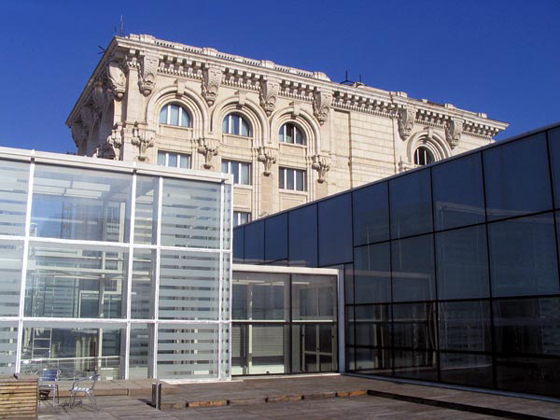
The MNAC typifies the old-with-new architectural mix of Bucharest, with is contemporary glass structure that juts out from the original neoclassical building
×Perhaps it is this series of contrasts and tightrope of urban re-infrastructure that inspired the team behind the '1:1' exhibition at the 2010 Venice Biennale to create its clean and tangible architectural measurement of Bucharest’s population density. When probed about its concept, the designers described it as ‘a relationship between an individual, interior, sacred, private, abstract space and a collective, exterior, profane, public, real space. The tension between these spaces keeps them united; one cannot exist without the other and both cannot exist without architecture.’
Bucharest is a city of striking contrasts, a quilt of good and bad patchwork. ‘Everyone is trying to find their own style in a bazaar of possibilities’ according to Corvin Cristian. There is undoubtedly an exciting new wave of creative talent in the Romanian capital, and belief in turning ideas into reality. Ultimately, Bucharest is a city eager to revive past glories and re-establish itself in the world of architecture and design.


